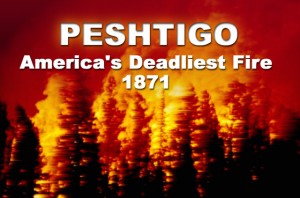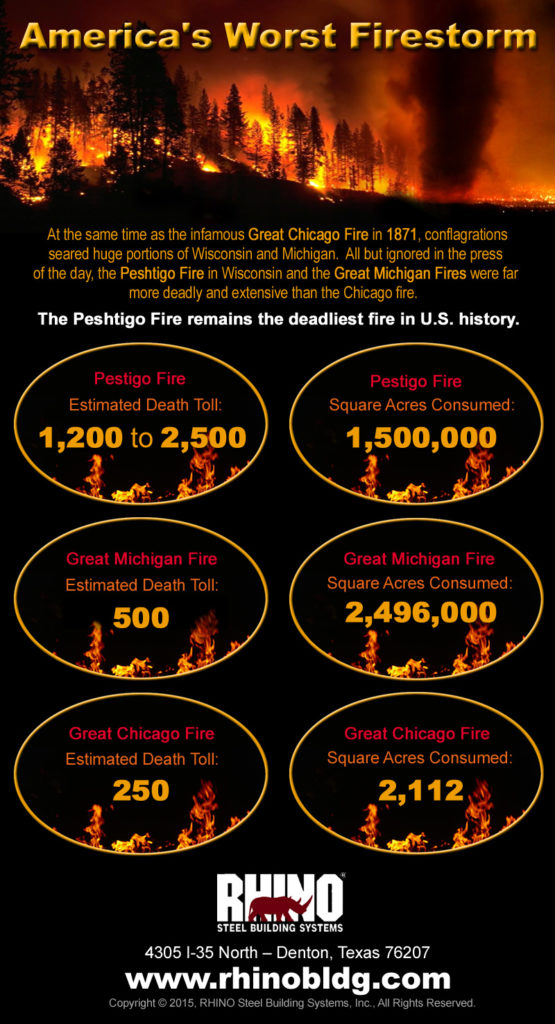When Wood, Wind, and Weather Created the Perfect Firestorm
The conflagration now known as the Peshtigo Fire claimed more lives than any other blaze in U.S. history. Starting on October 8, 1871, the fire destroyed Peshtigo, Wisconsin and other nearby communities, killing an estimated 1,200 to 2,500 souls.
 Most people have never even heard about the Peshtigo disaster— in spite of the fact that it happened on the same day as the infamous Great Chicago Fire.
Most people have never even heard about the Peshtigo disaster— in spite of the fact that it happened on the same day as the infamous Great Chicago Fire.
At the same time, a third massive fire destroyed huge portions of Michigan forestland and villages.
A Formula for Disaster
Peshtigo was west of the Green Bay— the “thumb” of Lake Michigan. Virgin forests covered the rich, fertile land. Logging and sawmill businesses abounded in the area.
Although the start of the 1871 fires remains unknown, four anomalies contributed to producing conditions perfect for cataclysmic fires:
- DROUGHT: Months of exceptionally hot weather over the spring and summer dried up creeks and lowered the Peshtigo River. Most areas had received two inches or less rain during the entire year. Trees and vegetation were tinder-dry.
- WIND: A massive low moving into the Great Lakes region whipped gale-force winds across Illinois, Wisconsin, Michigan, and parts of Minnesota and Ontario.
- WOOD: Never was so much dry fuel as readily available for the spread of a fire as in that area in October 1871. The forests were thick, rich with towering Eastern white pine trees 150’-170’ tall and 3’-5’ in diameter, along with red pine and ash, beech, birch, cedar, elm, maple, and oak. Logging in the area began in the early-to-mid-part of the 1800s. By 1871, wood dominated industry in the Great Lakes regions. Lumber was king. Peshtigo boasted he largest woodenware factory in the country, producing barrel covers, buckets, clothespins, tool handles, shingles, and tubs. Readily available and cheap, wood was used for all construction, from buildings to homes to bridges. Board sidewalks lined the streets. Sawdust and wood chips covered floors and roads to keep down the dust.
- CARELESSNESS: In man’s haste and greed, forest cleanup seemed unimportant. Brush was strewn everywhere. Lumbermen stripped felled trees of limbs, leaving the waste wood where it lay. Farmers cut trees to clear land, burning stumps and brush indiscriminately. Railroads cleared a way through the forests for tracks, shoving trees and debris to the sides— where it frequently caught fire from the engine sparks of a passing train. Fires became so common, people seldom noticed the burning.
In 1871, Peshtigo’s official population was 1,740. Immigrants seeking work at the mills and logging camps, and volunteers recruited to fight the frequent brush fires, swelled Peshtigo’s population to 2,000 that October.
 Whatever the source of the fire, when the cold front swept in with its howling winds, the fire quickly grew out of control. It became to a firestorm— a blaze so intense, it generates and sustains its own winds.
Whatever the source of the fire, when the cold front swept in with its howling winds, the fire quickly grew out of control. It became to a firestorm— a blaze so intense, it generates and sustains its own winds.
Survivors of the fire reported seeing a fire whirl— a tornado of fire— produced by the intensity of the fire. So strong was the inferno, it tossed whole houses and rail cars high into the air.
Hurricane-force winds topping 110 mph fanned the raging flames. In only 90 minutes, the firestorm decimated the town of Peshtigo. The bizarre blaze left survivors baffled and dazed.
• Almost half the population of Peshtigo died— 800 people. Whole families were wiped out.
• Only one structure remained standing, a house still under construction framed with wood so green it would not burn.
• The fire leveled Peshtigo and twelve other communities.
• Many bodies were unidentifiable, reduced to bone.
• All town records burned, making an accurate death toll impossible. Estimates of the Peshtigo Fire’s total fatalities range from 1,200 to 2,500.
• The Peshtigo Fire devoured 2,400 square miles of virgin forestlands, consuming two billion trees.
• Several people committed suicide when hope of escape was lost.
• Many were killed while crossing a wooden bridge, as it burned and collapsed into the Peshtigo River. The falling bridge crushed those seeking shelter in the frigid waters under the bridge.
• Many drowned or died from hypothermia as they sought refuge in the cold river.
• Men seeking protection in a large water tank were boiled alive.
• Temperatures reached 2,000 F. Sand on the streets turned to glass.
• One man, convicted of looting, was sentenced to death— but no rope could be found to hang him.
Burning simultaneously with the Great Chicago Fire and Peshtigo Fire, the Great Michigan Fire consumed 3,900 square miles of forest and killed an estimated 500 people. The blaze decimated several towns in Michigan’s Upper Peninsula.
The fire reduced thousands of homes and business in Michigan to blackened rubble and ash. Hundreds of families were left homeless— and without any wood left for rebuilding.
Fire-Resistant Steel Buildings
No building material could survive a raging inferno comparable to these devastating historical fires. However, these stores serve as a cautionary tale to today’s builders. Every precaution should be taken to reduce the risk of damage and loss of life in a fire.
Fire-resistant commercial-grade steel buildings remain the best preventative from the devastation of fire.
RHINO steel buildings create the strongest, most durable, most economical one and two-story steel buildings available today. Call RHINO today at 940.383.9566. Capitalize on the fire-resistant benefits RHINO metal buildings for your next construction project.
Other suggested blogs:
• “Every Second Counts in a Building Fire”
• “Structural Fires Devour Property and Ravage Lives”
• “Are We Losing the Battle with Wildfires?”
• “7 Fire Safety Tips”
• “10 Fire Prevention Tips”
